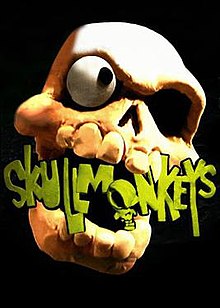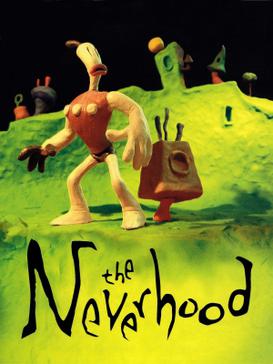
The Neverhood is a 1996 point-and-click adventure video game developed by The Neverhood, Inc. and published by DreamWorks Interactive for Microsoft Windows. The game follows the adventure of a claymation character named Klaymen as he discovers his origins and his purpose in a world made entirely out of clay. When the game was originally released, it was unique in that all of its animation was done entirely in claymation, including all of the sets. The gameplay consists mostly of guiding the main character Klaymen around and solving puzzles to advance. Video sequences help advance the plot. In addition to being unique, The Neverhood aimed at being quirky and humorous, as is evident by the characters, the music, and the plot sequence. It received a sequel in 1998, Skullmonkeys, which was a platform game, abandoning the adventure format of the original.

Douglas Richard TenNapel is an American animator, writer, cartoonist, video game designer, and comic book artist whose work has encompassed animated television, video games, and comic books. He is best known for creating Earthworm Jim, a character that spawned a video game series, animated series, and a toy line. He is also the creator of the animated television series Catscratch (2005–2007), which aired on Nickelodeon, and was itself a loose adaptation of TenNapel's comic book limited series Gear.

X-Men vs. Street Fighter is a crossover fighting video game developed and published by Capcom. It is Capcom's third fighting game to feature Marvel Comics characters, following X-Men: Children of the Atom and Marvel Super Heroes, and is the first installment in the Marvel vs. Capcom series. As the title suggests, the game includes characters from Marvel's X-Men franchise and the cast from Capcom's Street Fighter series. Originally released as a coin-operated arcade game in 1996, it was ported to the Sega Saturn in 1997 and the PlayStation in 1998.

NBA Live 99 is the fifth installment of the NBA Live video games series. The cover features Antoine Walker of the Boston Celtics. The game was developed by EA Sports and released on November 4, 1998, for the Nintendo 64, and then on November 10, 1998, for the Windows and PlayStation. Don Poier is the play-by-play announcer. It was the first NBA Live game released for Nintendo 64. NBA Live 99 was followed by NBA Live 2000.

The Lost World: Jurassic Park is an action-adventure video game developed by DreamWorks Interactive and Appaloosa Interactive, and published by Electronic Arts and Sega for the Sony PlayStation and Sega Saturn, respectively, in 1997. The Lost World: Jurassic Park is based on the film of the same name, which in turn is based on the novel by Michael Crichton. In 1998, a special edition of the game was released for the Sony PlayStation as a Greatest Hits title and featured several modifications to the gameplay.
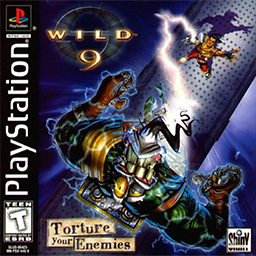
Wild 9 is a 2.5D platform video game for the PlayStation. The game was designed by David Perry, developed by Shiny Entertainment, and published by Interplay Productions; all of which were parties involved in Earthworm Jim series of video games. The game was released in North America and Europe in September 1998.

Earthworm Jim 3D is a 1999 platform game developed by VIS Interactive and published by Interplay Entertainment for the Nintendo 64. It is the third in the Earthworm Jim series and a sequel to Earthworm Jim 2. It was the first game in the series to not be developed by Shiny Entertainment, which had recently instituted a strict "no sequels" policy. Interplay Entertainment, having recently purchased the Earthworm Jim rights, handed the franchise off to VIS Interactive.

Chicken Run is a platform-stealth based 3-D platform video game based on the 2000 film of the same name. The game is a loose parody of the famous film The Great Escape. The Game Boy Color version is a 2D isometric puzzle-solving game. The game's plot is about chickens escaping from a farm from their evil owners and fighting for freedom.

Aero Fighters Assault is an arcade-style combat flight simulator developed by Paradigm Entertainment and published by Vic Tokai and Video System for the Nintendo 64 in 1997.
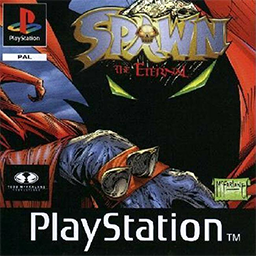
Spawn: The Eternal is an action-adventure video game developed by Sony Interactive Studios America and published by Sony Computer Entertainment for the PlayStation, based on the comic book character Spawn created by Todd McFarlane and produced by Image Comics. It was released on December 9, 1997 in North America and received poor reviews. When played on a CD player, the disc would be revealed to contain a lengthy audio interview with Spawn creator Todd McFarlane.

Spider: The Video Game, is a 2.5D platform game developed by Boss Game Studios and published by BMG Interactive for the PlayStation. The player takes the role of a cybernetic spider, within which the mind of its creator, Dr. Michael Kelly, has been implanted.
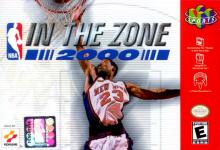
NBA In The Zone 2000 is a basketball video game released for the Nintendo 64, PlayStation, and Game Boy Color in 2000. It is the fifth and final installment of the NBA In The Zone series. The cover features Marcus Camby of the New York Knicks.
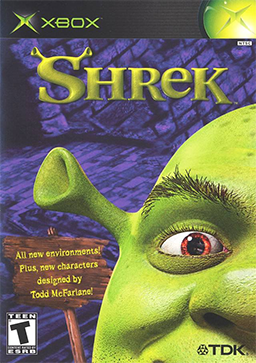
Shrek is a 2001 platform video game developed by Digital Illusions Canada and published by TDK Mediactive for the Xbox, based on the 2001 film Shrek. The game was released on November 15, 2001, as one of 22 North American launch titles for the Xbox and March 29, 2002, in Europe. A reworked version of the game, titled Shrek: Extra Large, was released for the GameCube on October 30, 2002, in North America and on October 24, 2003, in Europe. Shrek: Extra Large uses the same engine and game mechanics as the original Xbox release, but with an altered story and different levels.

Pitfall 3D: Beyond the Jungle is a platform game developed by Activision's internal Console Development Group and published by Activision in 1998 for the PlayStation and by Crave Entertainment for the Game Boy Color known as Pitfall: Beyond the Jungle in 1998. The game is part of the Pitfall series, following the 1994 installment Pitfall: The Mayan Adventure. It was first unveiled in 1996, when 3D platform gaming was still in its infancy, making designing the game a challenge. The PlayStation version development team included staff from the Virtua Fighter series, which was a pioneer in 3D gaming, but personnel changes led to Pitfall 3D being repeatedly delayed, and upon release critics sharply disagreed over whether it was a successful effort at bringing Pitfall into 3D.

Monkey Hero is an Action-adventure game developed by Blam! and published by Take-Two Interactive for the Sony PlayStation video game console. The game is similar to the likes of The Legend of Zelda and Secret of Mana and borrows many ideas from these games, such as a top-down perspective and gameplay focused on exploration, combat, and puzzle-solving. Gameplay elements include large dungeons, fighting and puzzles. It has a whimsical manga-inspired look that makes use of both 3D and 2D graphics.
Earthworm Jim is a series of platform games featuring an earthworm named Jim who wears a robotic suit and battles the forces of evil. The series is noted for its platforming and shooting gameplay, surreal humor, and edgy art style. Four games were released in the series: Earthworm Jim, Earthworm Jim 2, Earthworm Jim 3D, and Earthworm Jim: Menace 2 the Galaxy, with the first game released in 1994. The series had lain dormant for almost a decade before Gameloft remade the original game in HD for PlayStation Network and Xbox Live Arcade in 2010. Interplay announced Earthworm Jim 4 in 2008; little to no information surfaced until May 2019 and August 2020, and development went dormant once again by January 2023.
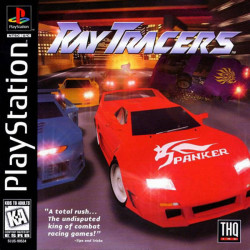
Ray Tracers is an arcade-style auto racing and combat video game developed by Taito and released in Japan and Europe in 1997 and in North America in 1998 for the PlayStation console. It has been compared to Taito's own Chase H.Q. from 1988.

Andretti Racing is a video game developed by American studios High Score Productions and Stormfront Studios and published by EA Sports for the PlayStation and Sega Saturn in 1996, and for Windows in 1997. The game's title refers to legendary racing drivers Mario Andretti and Michael Andretti.

Armikrog is a stop-motion point-and-click adventure comedy game by Doug TenNapel in partnership with Pencil Test Studios and Versus Evil for Microsoft Windows, OS X, Linux, PlayStation 4, Wii U and Xbox One. It is a spiritual successor to The Neverhood, and is developed by many members of the same team. Like The Neverhood, Armikrog uses clay animation.

BoomBots is a fighting game released in 1999 for PlayStation. It was created by Doug TenNapel, developed by The Neverhood, Inc., and published by SouthPeak Interactive. BoomBots features distinctive claymation visuals and various amounts of toilet humor. The game was both a critical and commercial failure.
